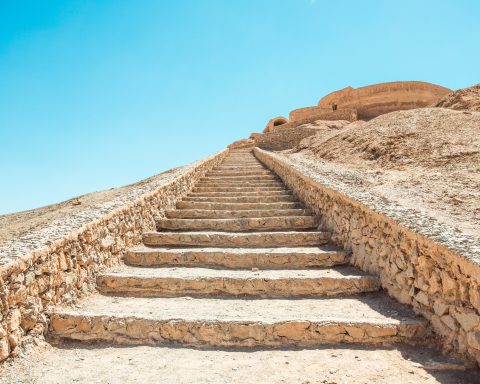Pathways to Sustainability

Editor’s Note:
The nature of recovery lies in the recovery of nature. With fires raging in the West and hurricanes hammering Texas and Florida, many of us wish our country were still trying to fulfill its Paris climate pledge, and not gutting the EPA or unleashing polluters. Yet our challenge goes beyond developing scientifically credible policies (needed as they are!). It is a matter of ethos and worldview. A version of this piece appeared in a booklet that was prepared for an Ethics in Action event at the Vatican and was subsequently distributed at the Louisville Festival of Faiths (both in 2017). In it, Dr. Johnston shows how a new worldview is present within two religious teachings (Presbyterian and Roman Catholic), as well as at the growing edge of international government policy (with Prince Charles of Great Britain as a surprising bellwether).
Presbyterians have been wrestling with the challenges of the environmental crisis, and witnessing to the necessity of changing the way we live on this earth, for more than 50 years now. The early 1970’s resolutions on environmental limits culminated in “The Power to Speak Truth to Power” (1981), in which the church affirmed the ethical norms of justice, sustainability, sufficiency, and participation, with twelve guidelines to aid in realizing these norms in actual circumstances of life. At the 218th General Assembly in 2008, the church reaffirmed its longstanding commitment to ecojustice, with the understanding that the climate crisis that is upon the world is urgent and unprecedented:
“Together with people all around the world Christians at the outset of the 21st century must respond to this climate crisis by developing a new way of living in harmony with Earth’s energy resources and in solidarity with all of God’s creation. Actions taken or not taken today will impact the welfare of the planet for centuries to come.”[1]
In these last twenty years the insight above, that there needs to be “a new way of living in harmony,” has been developed into a way of understanding what needs to be done that has real promise for clarifying and encouraging the rapid changes needed…changes that the massive impact of Hurricane Harvey in Texas and Louisiana, the fires across the American west, and the millions suffering from terrible flooding in Asia, make more vivid than ever. In consonance with the statement above, both Pope Francis and the Prince of Wales have advocated for this way of understanding in their work. It is significant that stewards of two of our oldest institutions are blessing this shift.
The core of this understanding is that the world needs to shift from working against nature’s creativity to working with the creativity that God has woven into nature. While the damage already done, and to come, is terrible, and happening even faster than predicted, and the necessary work to change can be daunting, the good news is that the world is learning how to make this shift, and is moving away from the destructive practices of the industrial revolution to healthier practices more in harmony with the creativity of God’s creation. The sustainability revolution is also happening faster than anyone predicted, and is now well underway! The question is, how fast can the shift be made, and how much can the destructive consequences of climate change be mitigated?

This essay will offer some proposals for how to utilize health and harmony as a way to think that can aid efforts to build a more just, sustainable, and peaceful world. In a world filled with the suffering caused by “human bloodshed and violence to the earth” (Habakkuk 1:17), it may seem an overwhelming task. On our own, it can be hard to see how to make real progress toward building the better world we seek. Yet positive and effective “pathways”, which can help people move their communities in a healthier direction, are already being built. Pathways can help people see that this is not an impossible ideal, but truly practical and transformative, so that human beings can thrive together with all life in “our common home,” as Pope Francis puts it in Laudato Si’.
One powerful key to developing these pathways is the concrete usefulness of “health and harmony” as an organizing image. Health is a concrete dimension of life, one that anyone can understand. Ordinary people know when they are getting healthier or getting sicker. And people in long-term relationships, such as marriage, know when those relationships are fraying and going wrong, or deepening, and going “right” and getting healthier. We all experience health from the inside, concretely and integrally.
A good example of how looking carefully at health can provide pathways forward can be found in medicine itself. For much of the last century, Western medicine was oriented to “fixing” bodily problems as they arose. Great strides were made in treating heart disease, for example. Yet only gradually have physicians begun to understand that it is better to prevent heart disease than treat it after it causes a crisis, and that prevention is most effective if human beings learn to live healthier lives. Healthy lives, in turn, are now understood to be multi-faceted and include not just individual choices like healthy eating and exercise, but relational dimensions like family, work, community participation, and spiritual life – and all this lived in the fundamental context of a healthy ecosystem. Life truly is “integral” and inter-connected and thrives only when all these dimensions of dynamic relationality are relatively healthy.
___________________________________________
Harmony requires urgently that we shift, in multiple dimensions of life, from working against the creative processes built into nature to working instead with those creative processes.
___________________________________________
Hand in hand with Health comes Harmony, the concept that helps human beings understand how life is meant to be lived in dynamic balance with all else. Indigenous peoples have developed cultures of harmony that have enabled them to live for thousands of years. Much has been learned in recent years about the cost of ignoring the ways of harmony – of ignoring the wisdom embedded in nature – and movements to recover that wisdom and adapt it are developing rapidly. It is this holistic side, a combination of inside and outside change for sustainability with justice, that has been lifted up by both His Highness the Prince of Wales and His Holiness Pope Francis. Harmony requires urgently that we shift, in multiple dimensions of life, from working against the creative processes built into nature to working instead with those creative processes.[2] Reforming science, technology, business, and every other area of life to make a shift toward Harmony will go a long way to achieving sustainability and building peace.
Positive changes are underway in multiple arenas. New, more effective measures of community and natural health are being developed, including social indicators that tell us much more about community well-being than economic indicators do, and scientific measures of ecosystem dynamics that provide a clearer picture of the damage being done to our biosphere and to us. For the first time in the modern era, we are beginning to know the “true costs” of human activity, both economically and in terms of health. These measures have led to such projects as “quality of life” indexes to balance the problematic emphasis on GNP, and also to the UN Sustainable Development Goals, which are helping nations throughout the world understand and track their progress with measures of the well-being of their people and lands.
From a faith perspective, the multiple ways of actively building “integral and sustainable human development” are ways that unleash God-given creativity back into technologically over-driven structures. For example:
- Biomicry is leading the way in the shift to learning from and working with nature instead of against it by teaching business how to work sustainably yet still for profit.
- Corporations are also learning how to reduce waste radically and make large gains in energy efficiency. They are also incorporating social methods of better utilizing human talents, through teamwork and by encouraging more input and initiative from workers.
- Architects are proving that buildings can be both “energy-generating” and affordable.
- Agroecology is bringing science and traditional wisdom about farming together, and showing that this approach is both more sustainable and more productive than industrial agriculture, as well as building the health and harmony of land and people.
- In social development, Asset-based Community Development is showing how efforts to address poverty can benefit by starting from the premise that every human being has God-given gifts that can be encouraged and contributed to the community, rather than starting from a focus on deficits. Social entrepreneurship also shows much promise for addressing poverty by using the asset-based approach.
- Restorative justice is another pathway, and is showing what indigenous peoples have always known – that true justice is the restoration of healthy relationships, or harmony, in a family or community, and this is more far effective than punishment alone.
In all of these approaches, the basic questions of what the healthiest way to work is, or whether a technology is leading to greater health and harmony or to less, are very useful. For example, a small group was asked to work on solutions to a recurring flooding problem in a community. At first all the suggestions were based on “hard” engineering: dams, flood walls, etc. But when the group was asked if they could come up with solutions that work with nature instead of against it, the whole conversation changed radically: the same group started to think of using natural swales and rain gardens that capture water, of building design that catches water, including permeable pavement, and many other ideas. Many of the participants already knew about these possibilities, but didn’t think of them until invited to work with nature. Once they did, the energy in the group rose, imaginations were fired, and enthusiasm and commitment to solving the problem jumped. This approach is not only workable, it is truly satisfying.
___________________________________________
When the vision of a world that is just, peaceful, and sustainable is aided by the concepts of Health and Harmony, the vision becomes more coherent, constructive, and concrete.
___________________________________________
In fact, it will be useful to look at ways to incorporate criteria for health and harmony into economics itself – even into economic theory. Crucially, modern capitalism places the concept of humans as homo economicus at the center – treating all human beings as if they are individuals concerned only with making market decisions. Every other dimension of human life is effectively stripped out and ignored. This aspect of economic theory has had immense consequences in actual economic life, including the unthinking destruction of human communities and the natural ecosystems they depend on. What would change if, instead of homo economicus, economics incorporated at its center an image of homo salutaris – the healthy human? Instead of ignoring every other aspect of human life, economists would figure out how to take into account the reality that a healthy human needs healthy networks of relationships with family, community, and ecosystem, and that something is terribly wrong when these essential dimensions of life are damaged instead of strengthened.[3]
When the vision of a world that is just, peaceful, and sustainable is aided by the concepts of Health and Harmony, the vision becomes more coherent, constructive, and concrete. This is how we recognize the many pathways for human activity to work with nature’s creativity, working to move the world away from violence and ecological destruction, and instead toward peace and sustainability.
This work is what theologian Thomas Berry called “the great work.” It is work that should resonate especially with people of faith, as it is about learning from God’s creation how to realign human activity with God’s activity (as expressed in nature). Many Protestant denominations and Orthodox churches are joining Pope Francis and the Catholic Church to encourage this work – work that serves the call of His Holiness Pope Francis for a “radically positive approach” that affirms human dignity and the love of God for God’s creation while “valuing and preserving all of life and empowering all.” The Presbyterian statement puts it this way:
“Our Reformed tradition reminds us that it is God who created the earth and saw that it was good, God who sustains the earth and seeks to hold its processes together, God who judges sin and greed, and God who reveals in Jesus Christ that love and justice are the essence of God’s power. God is the inexhaustible source of energy for personal, social, and ecological transformation. Although we are complicit in the evils we face, we can repent of our own sinful misuse and abuse of the Earth as we confess our sins. As recipients of God’s endless mercy, this redemptive energy frees and empowers us to be good stewards of God’s creation.”[4]
God’s redemptive energy frees us, so that we can participate in God’s great work of restoring the world for the thriving of all life together. This is a true vision of the “life abundant” that Jesus came to offer the world.
***
Author Bio: Rev. Dr. Carol Frances Johnston has taught ecojustice at Christian Theological Seminary in Indianapolis since 1991. She is ordained in the Presbyterian Church (USA) and has served on the Presbyterian eco-justice task force and several ecumenical projects. She is the author of “And the Leaves of the Tree Are for the Healing of the Nations: Biblical and Theological Foundations for Eco-justice” and The Wealth or Health of Nations: Transforming Capitalism From Within.
[1] “The Power to Change: U.S. Energy Policy and Global Warming,” p. 6.
[2] See the 2015 address, “Health and Harmony,” by the Prince of Wales at the Cathedral of the Assumption in Louisville, KY, USA at https://www.youtube.com/watch?v=ql2bXFqjxQs and the book Harmony: A New Way of Looking at Our World. Also the papal encyclical Laudato Si’, which can be found at https://laudatosi.com/watch.
[3] For a full explanation of the impact of homo economicus, and proposals for changing it, see my book The Wealth or Health of Nations: Transforming Capitalism From Within (Wipf and Stock, 2010).
[4] “The Power to Change: U.S. Energy Policy and Global Warming,” p. 8






Unbound Social